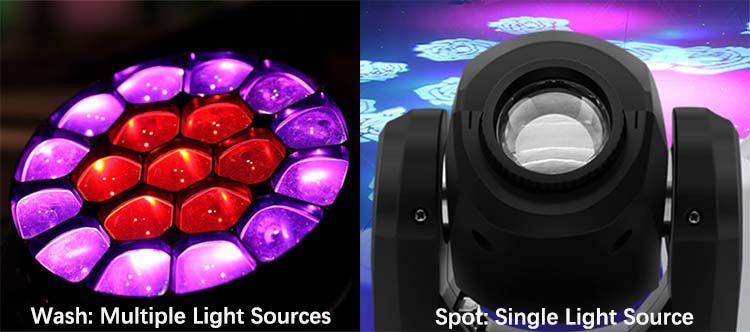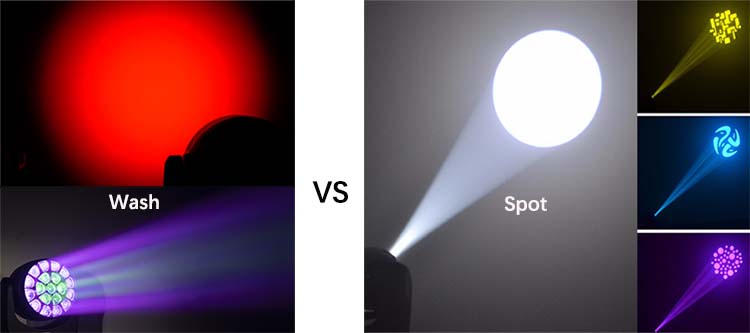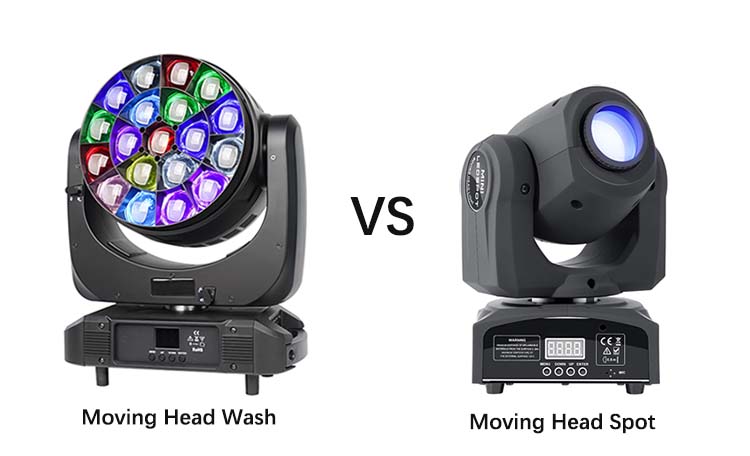Moving Head Wash vs Spot
In the world of stage and concert lighting, the moving head fixture has become an essential tool for lighting designers. These fixtures are capable of producing a wide range of lighting effects, making them extremely versatile and useful in a variety of different settings. However, there are two main types of moving head fixtures: movign head wash and moving head spot. Understanding the differences between these two types of fixtures can help lighting designers make more informed decisions about which one to use in different contexts.
• Light Source
• Projected Light
• Use
• Control Mode
Light Source

First, let’s take a closer look at the moving head wash fixture. This type of fixture is designed to produce a broad, even wash of light across a wide area of the stage. Wash fixtures typically utilize multiple light sources, such as LED bulbs, to create an immersive environment that can enhance the mood and overall feel of a performance. The result is a soft, graduated light that can create a sense of depth on stage. Wash fixtures are ideal for background lighting, as they can easily light up the entire stage without overpowering the performers or other elements of the production.
Moving head spot fixtures, on the other hand, are designed to highlight specific areas or performers on stage. These fixtures produce a narrow, focused beam of light that can be aimed and adjusted to focus on a particular location. Spot fixtures are ideal for creating dramatic effects, such as spotlighting a solo artist or actor, creating shadows and silhouettes, or highlighting a specific section of a musical piece. Spot fixtures generally feature a single, brighter light source that allows for the creation of sharp and well-defined beams of light.
Projected Light

The way of projecting light is different is the main difference between these two moving head lights. Wash fixtures utilize multiple light sources to produce a broad, even wash of light, while spot fixtures rely on a single, brighter light source to produce a narrow beam of light. Wash fixtures tend to produce a softer, more gradual light, while spot fixtures produce a sharper, more well-defined beam.
Use
Another key difference between the two is their intended use. Wash fixtures are designed to create a broad, immersive environment that can enhance the mood and overall feel of a performance. They are perfect for background lighting and can easily light up the entire stage without overpowering the performers or other elements of the production. Spot fixtures, on the other hand, are designed to highlight specific areas or performers on stage. They are ideal for creating dramatic effects and drawing attention to particular elements of a performance.
Control Mode
Finally, there are differences in the way in which they are controlled. Both wash and spot fixtures are controlled by a lighting console, which allows the lighting technician to manipulate their output and change their color, position, and intensity. However, the way in which they are programmed and controlled can differ slightly. Wash fixtures may require more subtle and gradual changes in order to maintain the overall immersive environment they create, while spot fixtures require more sudden and dramatic changes to highlight specific performers or elements of the production.
In conclusion, moving head wash and spot fixtures are both essential tools for lighting designers in the world of stage and concert lighting. They offer a wide range of lighting effects and can be used in a variety of different settings to enhance performances and create immersive environments. Understanding the differences between these two types of fixtures is crucial in order to make informed decisions about which one to use and how to control them. With the right combination of wash and spot fixtures, lighting designers can create dynamic and exciting stage lighting that can truly elevate a production.
Post time: Apr-14-2023

